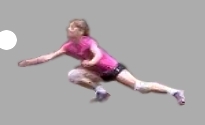Preparation - Position and Readiness back to top
Position refers to the player's position
on the court. As the play progresses, the player must
continuously adjust position in order to maintain the best position to be ready
for any outcome.
This is done taking into consideration many things, including the ongoing play, position
relative to the position of other players, and general rules of positioning in different
circumstances.
Readiness refers to the player's readiness to react
to the ongoing play and execute the appropriate skills as required. The player must maintain
optimal court and body position, be mentally focused on the ongoing play, and also use
techniques that reduce reaction time.
So, position and readiness are interrelated and both very important prerequisites
to the proper and successful execution of game skills.
Volleyball is a dynamic game where the ball can travel very quickly, so a
player must constantly be ready to react very quickly to defend against
successful attacks by the opposing team, and to recover from sudden and
often unexpected turns of the play such as mis-hits and errors made by team-mates.
TECHNIQUE TIP
SKILLS tt-1
A player who is in correct defensive position and ready to quickly respond to the play
should always remain in motion, shifting weight and "moving the feet" (vibrating).
A stationary player who is maintaining court position should be constantly shifting weight
from one leg/foot to the other by raising the heel of each foot in turn in an alternating
left-right-left-right sequence. The heel is raised only a few centimeters (approx. 1-5) while the
rest of the foot remains on the ground still supporting some of the player's weight.
The lifting of the heels and shifting of weight (vibrating) is executed quite rapidly - up to 5 times
per second. When a player is more relaxed and waiting on the play, the vibrating can be
executed at a slower pace (perhaps 2 times per second) but as the player anticipates an imminent
play and a required response, the pace should be quickened up to the maximum rate.
This reduces the time it takes the player to begin to move quickly into any given new
position as required in reaction to the ongoing play.
This technique is similar to the foot-shuffling/weight-floating technique tennis players use when
preparing to receive service.
Upon analysis, we see that the first action of a person beginning to bolt (move) in any direction
is to take an "initial step" in the opposite direction with one leg, shift weight onto it, and push-off
with it, thus propelling the body in the desired direction.
The vibrating technique aims to ensure that in the moments before decision, the player is
almost always in the process of taking (or about to take) the right "initial step" to begin moving.
The Roll back to top

The Roll is a quick action executed in order to receive (or save)
a ball that is dropping in front of a player on the left or right side and that is
sufficiently out of reach or traveling too fast for the player to be able to get under
the ball to execute a more controlled underhand reception (bump). "Roll" refers to
the method used to safely run out (dissipate) the kinetic energy of the
player's body in motion.
The player simultaneously lunges, or steps toward the ball (target) with the
closest (leading) leg and extends the leading arm (or arms) and reaching over
the leg towards the ball while the body is lowered over the leg and is
propelled in the direction of the ball by the other leg. Once the outreaching wrist or arm
makes contact with the ball, the energy of the player's rapid motion towards the ball is
dissipated by lowering the body further and smoothly contacting the ground with the leading
shoulder and side, rolling over the shoulder and the full back and the opposite shoulder,
and then finishing the Roll by allowing the last of the energy to help raise and
bring the body back to a standing and ready position.
The player can contact the ball using the more controlled and prefered two-armed
underhand (bump) method, or in situations where that is not possible (the target
is off to one side and/or a very quick reaction is required) the one-arm method
may be more appropriate.
Animation: Roll (one arm)
Ideally, the player's entire back contacts the ground during the Roll so that impact forces are
spread over as large an area as possible, and the player's spine is roughly pointing in the
direction of the play while the back is in contact with the ground.
When the Roll is executed properly, the player's arms do not contact or only barely touch the
playing surface, the player can maintain visual contact with the play, and the risk of injury
due to hard contact with the ground is eliminated.
This maneuver is valuable when a very quick reaction by the player is required, and can
also be adapted to receive a ball that is dropping directly in front of the player.
It can be executed when a dive is not possible due to the rules of play (diving
into the opposing team's side) or there are physical obstacles (walls, standards,
other players).